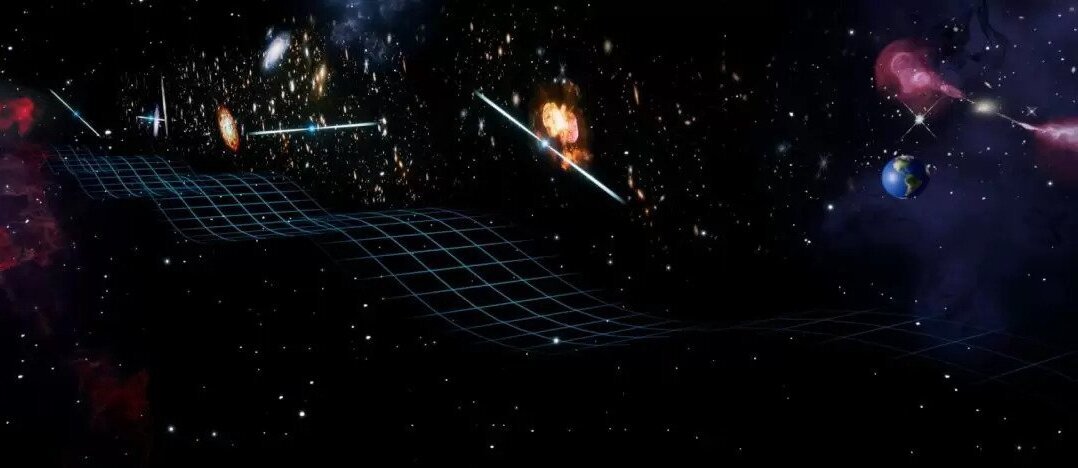Scientists Discover Massive Black Holes' Gravitational Waves Using 'Cosmic Clocks'
Radio Telescope Observations of Pulsars in Our Galaxy Unveil Distortions in Spacetime Caused by Enormous Gravitational Waves
 |
| Credit: National Science Foundation/Keyi "Onyx" Li |
Imagine everything around you, including your own body, slowly expanding and shrinking. This mind-bending phenomenon is the result of gravitational waves passing through our galaxy, as revealed by a recent study conducted by the U.S. National Science Foundation's NANOGrav Physics Frontiers Center.
The study, published in The Astrophysical Journal Letters, involved the North American Nanohertz Observatory for Gravitational Waves (NANOGrav), a collaborative effort between researchers from over 50 institutions in the U.S. and abroad. By analyzing millisecond pulsars, burned-out stars that emit radio pulses like highly accurate cosmic clocks, the team identified variations in their ticking rates. These variations were caused by low-frequency gravitational waves distorting the fabric of spacetime.
Essentially, the gravitational waves cause space to stretch and squeeze between Earth and the pulsars, resulting in the pulsars' radio pulses reaching Earth either slightly earlier or later than expected. This discovery provides the first evidence of the gravitational wave background, a pervasive distortion of spacetime that scientists have long theorized.
"The NSF NANOGrav team has essentially created a galaxy-wide detector capable of revealing the gravitational waves that exist throughout our universe," said NSF Director Sethuraman Panchanathan. "This collaboration demonstrates that world-class scientific innovation can reach every corner of our nation."
Gravitational waves were initially predicted by Albert Einstein in 1916, but it wasn't until 2015 that the Laser Interferometer Gravitational-Wave Observatory (LIGO) confirmed their existence by detecting spacetime ripples. The distortions detected by LIGO, resulting from the collision of distant black holes, were smaller than an atom's nucleus.
In contrast, the NANOGrav team measured apparent time shifts in pulsars on the scale of a few hundred billionths of a second, equivalent to the flexing of spacetime between Earth and the pulsars over the length of a football field. These immense spacetime distortions were caused by gravitational waves with a distance between two crests of 2-10 light-years, roughly 9-90 trillion kilometers.
"These gravitational waves are the most powerful ever discovered," said Maura McLaughlin, an astrophysicist at West Virginia University and co-director of the NANOGrav Physics Frontiers Center. "Detecting these colossal waves requires an equally massive detector and great patience."
Using 15 years of astronomical data collected by radio telescopes at NSF-supported observatories, including the Green Bank Observatory in West Virginia, the Very Large Array in New Mexico, and the Arecibo Observatory in Puerto Rico, the NANOGrav team created a "detector" consisting of 67 pulsars scattered across the sky. They compared the ticking rates of pairs of pulsars and, through advanced data analysis, identified the presence of the gravitational wave background causing spacetime distortions and explaining the observed timing changes.
"This is the first evidence of gravitational waves at these low frequencies," said Stephen Taylor, an astrophysicist at Vanderbilt University and chair of the NANOGrav collaboration. "The most likely source of these waves is distant pairs of close-orbiting, ultra-massive black holes."
"The universe's physical nature still holds many mysteries, and that's why the National Science Foundation supports ambitious projects like NANOGrav, to expand our knowledge for the benefit of society," said Sean L. Jones, NSF Assistant Director for Mathematical and Physical Sciences.
The team's findings offer new insights into galaxy evolution and the growth and merging of supermassive black holes. The widespread spacetime distortions revealed in their research suggest that there may be an extensive presence of extremely massive black hole pairs throughout the universe, possibly numbering in the hundreds of thousands or even millions. In the future, the NANOGrav team aims to identify specific pairs of supermassive black holes by tracing the gravitational waves they emit. They may even uncover traces of gravitational waves from the early universe.
"As we delve deeper into our data, we are not only sensing something, but we are discovering the symphony of the gravitational universe," said Xavier Siemens, co-director of NANOGrav and an astrophysicist at Oregon State University. "As we continue to listen, individual instruments will emerge in this cosmic orchestra."
The groundbreaking findings from the NANOGrav team not only validate Albert Einstein's century-old predictions but also open up new avenues for understanding the fundamental nature of the universe. By studying gravitational waves, scientists can gain valuable insights into the dynamics of black holes, the evolution of galaxies, and the origin of our universe itself. The collaborative efforts of researchers from various institutions across the United States demonstrate the incredible potential of scientific innovation and its impact on society.
The future holds exciting possibilities as we continue to unravel the mysteries of the cosmos, tuning in to the captivating melodies played by the gravitational waves that permeate our universe.
